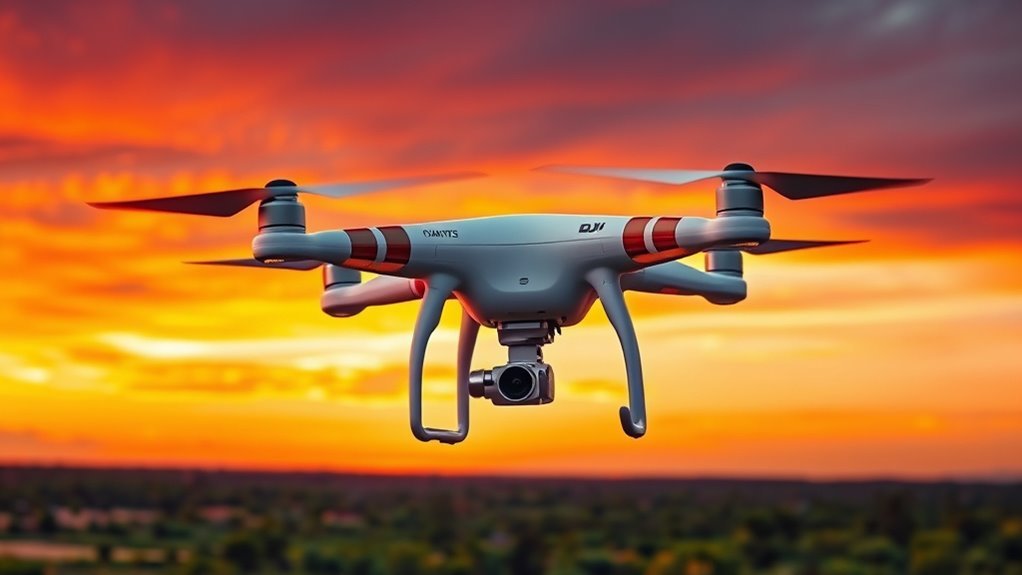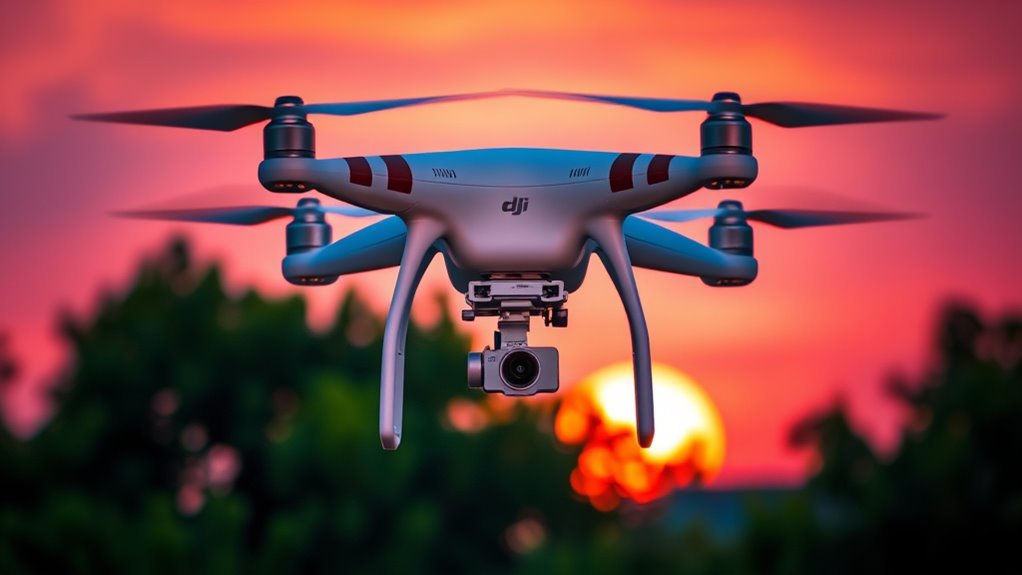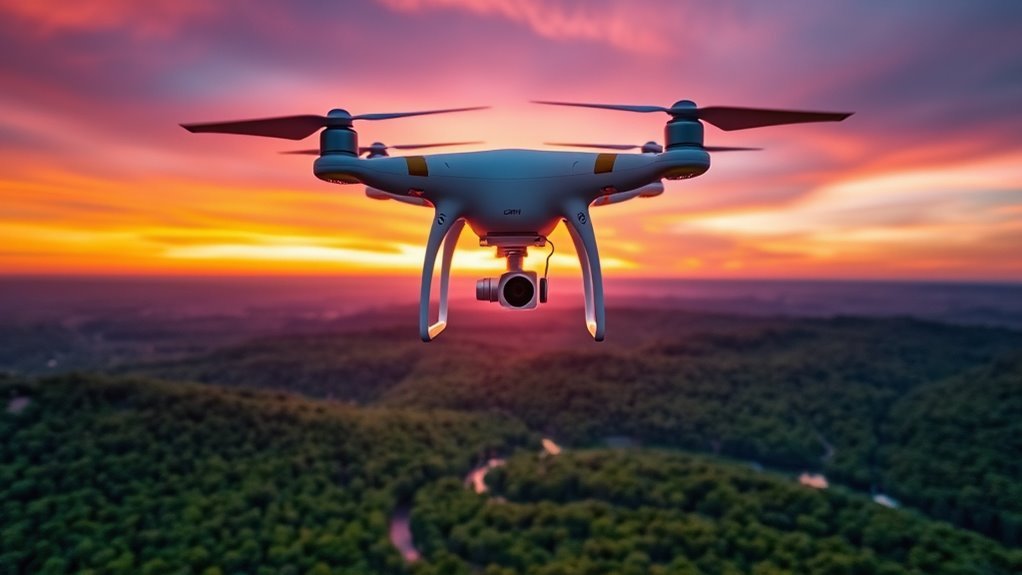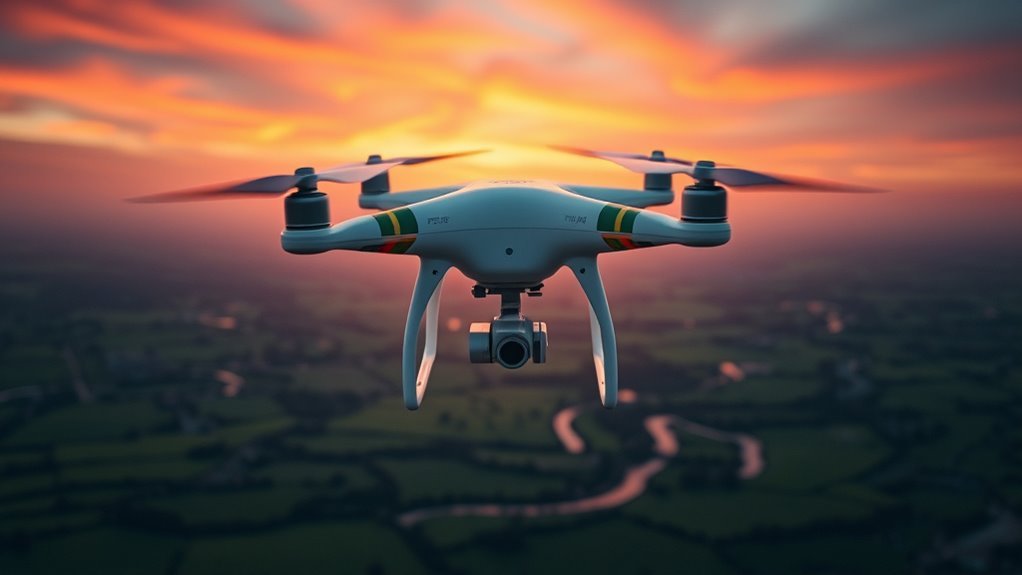You’ll appreciate the DJI Phantom 2’s robust, lightweight design and stable flight performance, offering reliable control even in moderate winds. Its camera system supports multiple mounts, delivering decent aerial shots for enthusiasts, though it lacks advanced low-light capabilities. Battery life lasts about 25 minutes, with safety features like low voltage alarms. While priced competitively, total cost rises with accessories. If you want to explore its customization options, flight modes, and overall value, there’s more to uncover.
Design and Build Quality

The design of the DJI Phantom 2 reflects a balance between functionality and durability, crafted to meet the demands of both casual users and enthusiasts. When you examine its design aesthetics, you’ll notice a streamlined, minimalistic form that enhances both visual appeal and aerodynamic efficiency. The drone’s body combines lightweight materials with robust construction, ensuring material durability without compromising flight agility. This thoughtful design allows you to enjoy extended use in various environments, providing the freedom to explore without constant worry about wear or damage. The modular build also facilitates easy repairs and upgrades, which means you can adapt the drone to your needs. Overall, the DJI Phantom 2’s design prioritizes longevity and practical elegance, enabling you to focus on your aerial adventures with confidence.
Flight Performance and Stability

Although mastering the DJI Phantom 2’s flight controls requires some practice, you’ll find its performance remarkably responsive and stable once accustomed. The drone offers multiple flight modes, including beginner and sport, allowing you to tailor control sensitivity based on your comfort level and desired freedom. Its stabilization system effectively counters minor disturbances, maintaining smooth flight paths. In moderate wind conditions, the Phantom 2 exhibits impressive wind resistance, holding position with minimal drift, which is essential for precise maneuvering. However, in stronger gusts, you’ll need to adjust your inputs carefully to maintain control. Overall, the Phantom 2 provides a balanced combination of agility and stability, enabling you to confidently explore open skies with reliable responsiveness and consistent handling across varied flight environments.
Camera Capabilities

DJI Phantom 2’s camera capabilities offer a solid foundation for aerial photography and videography, though they reflect the technology standards of its release period. You’ll find the image quality adequate for enthusiasts seeking clear, stable shots, but it may not meet the expectations set by more recent drone models. The Phantom 2 supports various lens options through compatible gimbals, allowing you to customize your visual perspective and achieve smoother footage. However, the fixed sensor size and limited resolution constrain dynamic range and low-light performance. If you prioritize freedom in capturing expansive landscapes or dynamic action, the Phantom 2 provides a reliable platform, although upgrading lenses or sensor technology is limited. Overall, it balances versatility with the era’s technical boundaries, giving you creative control within defined parameters.
Battery Life and Charging
When planning your flight sessions, understanding the Phantom 2’s battery life and charging process is vital for maximizing your drone’s operational efficiency. The drone’s battery typically offers around 25 minutes of flight time, which means you’ll want to prepare accordingly. Efficient battery maintenance and proper charging accessories can extend both flight duration and battery longevity.
Consider these battery maintenance tips and charging strategies:
- Use original charging accessories to guarantee safe, ideal charging cycles.
- Store batteries at room temperature and avoid full discharges to prolong lifespan.
- Rotate between multiple batteries to maintain consistent flight readiness.
- Regularly inspect batteries for swelling or damage to prevent failure mid-flight.
Controller and User Interface
Managing your battery life efficiently sets the stage for an uninterrupted flying experience, but equally important is how you control the Phantom 2 and interact with its user interface. The controller layout is thoughtfully designed, featuring ergonomic grips and intuitive stick placement that promote precise maneuvering without fatigue. Buttons are strategically positioned for quick access, allowing you to adjust settings on the fly. The user feedback system, though basic by modern standards, provides essential status updates through LED indicators and audible alerts, ensuring you stay informed about connectivity and battery levels. This streamlined interface supports your desire for freedom by minimizing distractions and enabling smooth, responsive control, allowing you to focus on piloting rather than steering through complex menus or controls.
Safety Features and Reliability
When flying the DJI Phantom 2, you’ll want to understand how its safety features impact reliability. The drone lacks advanced obstacle avoidance technology, which means you’ll need to be extra cautious in complex environments. However, its battery management and flight stability systems provide consistent performance, helping reduce the risk of unexpected malfunctions.
Obstacle Avoidance Technology
Although the Dji Phantom 2 drone lacks advanced obstacle avoidance sensors found in newer models, understanding its safety features is vital for reliable operation. Without cutting-edge sensor technology, you’re relying heavily on your own skill and the drone’s basic navigation systems to prevent collisions. The Phantom 2’s design encourages manual control vigilance rather than automated obstacle detection.
Key points to reflect on include:
- No integrated obstacle avoidance sensors; pilot attentiveness is significant
- Utilizes GPS-assisted navigation, aiding in stable flight but not collision prevention
- Visual line-of-sight operation is recommended to maintain spatial awareness
- Firmware updates may improve flight stability but won’t add obstacle sensing
If you value freedom in flight, mastering manual control and situational awareness becomes your primary safety tool.
Battery Life and Safety
Beyond traversing obstacles, the reliability of your Dji Phantom 2 heavily depends on its battery life and safety features. The drone uses a high-capacity LiPo battery, delivering up to 25 minutes of flight time under ideal conditions. To maximize this, you’ll need consistent battery maintenance, including proper charging cycles and storage at recommended temperatures. The Phantom 2 incorporates safety precautions such as low voltage alarms and automatic power cutoffs to prevent over-discharge, which can damage the battery and compromise flight safety. By adhering to these precautions, you reduce risks of sudden power loss mid-flight, enhancing the drone’s reliability. This focus on battery care guarantees you maintain freedom in the air without unexpected interruptions, allowing you to fully explore your aerial capabilities with confidence.
Flight Stability Systems
Flight stability is a critical factor that directly influences the safety and reliability of your Dji Phantom 2. Its advanced flight control system integrates multiple stabilization techniques to guarantee smooth, responsive handling even in challenging conditions. You’ll appreciate how these features allow you to maintain precise control while enjoying the freedom to explore.
Key flight stability systems include:
- GPS-assisted hover for consistent positioning
- Inertial Measurement Unit (IMU) for real-time orientation data
- Barometric altimeter maintaining steady altitude
- Intelligent flight control algorithms adapting to environmental changes
Together, these components work seamlessly to minimize drift and counteract turbulence, providing reliable performance. This blend of technology not only enhances safety but also empowers you to push the boundaries of your aerial creativity with confidence.
Accessories and Compatibility
While the DJI Phantom 2 offers impressive performance on its own, its true potential is revealed through a range of compatible accessories designed to enhance your experience. You can equip propeller guards to protect the drone’s blades from damage during tight maneuvers or accidental collisions, giving you more confidence to explore freely. Additionally, upgraded landing gear extends the clearance between the drone and the ground, allowing for better stability on uneven surfaces and protecting onboard cameras. The Phantom 2 also supports various gimbals and camera mounts, expanding your creative possibilities. Its compatibility with third-party batteries and remote controllers means you can customize flight time and control range to fit your unique needs. These accessories collectively empower you to tailor the drone’s functionality without limiting your freedom to fly.
Price and Overall Value
Having explored the range of accessories that enhance the Phantom 2’s functionality, it’s important to contemplate how these additions, along with the drone’s base features, impact its price and overall value. When you weigh the cost comparison against market alternatives, the Phantom 2 offers a compelling balance between performance and affordability. Consider these factors:
- Base price is competitive for its category but can rise with add-ons.
- Accessories increase versatility but affect total investment.
- Market alternatives may offer newer tech but often at higher costs.
- The Phantom 2’s proven reliability adds intangible value over cheaper models.
If you prioritize freedom in flight and quality, the Phantom 2’s price reflects a sound investment, especially when factoring in durability and feature set compared to similarly priced options.

